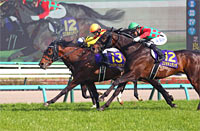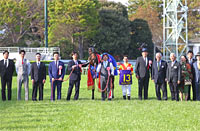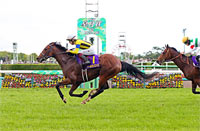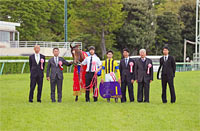Satsuki Sho (Japanese 2000 Guineas) (G1) - Data Analysis
First leg of Triple Crown promises fierce battle between top three-year-olds of current generation
After winning the Satsuki Sho (Japanese 2000 Guineas) in 2019, Saturnalia was voted the Best Three-Year-Old Colt in the JRA Awards of the same year. Since 2010, six (over half) of the 10 runners that were awarded the title of Best Three-Year-Old Colt in the JRA Awards had previously won the Satsuki Sho. In addition, among the 36 Tokyo Yushun (Japanese Derby) winners since 1984 (when the grading system was introduced), only eight had not appeared in the Satsuki Sho. In other words, this race not only marks the first leg of the classic Triple Crown, but also influences subsequent general trends in the racing program. Let’s now analyze some features shared by successful runners in this race based on results over the last 10 years, including the 2011 race held at Tokyo Racecourse.
Check track record since end of previous year
Of the 30 Top 3 finishers over the last 10 years, 23 had experience of finishing “1st” in “a JRA, open-class, turf 1,600–2,000m race held since late December of the previous year.” Conversely, runners with a highest finish of 5th or lower in such a race, and those that had not entered such a race, were all beaten to 4th or lower. This suggests that we should focus on runners that have performed well in the Hopeful Stakes held on December 28, 2019, or in any other graded, open-class, turf 1,600–2,000m race held since the start of the year. [Table 1]
[Table 1] Performance by highest finish in JRA open-class, turf 1,600–2,000m race held since late December of the previous year (last 10 years)
| Highest finish |
Performance
[1st-2nd-3rd-4th or lower] |
Win ratio |
Top 2 ratio |
Top 3 ratio |
| 1st |
8-9-6-51 |
10.8% |
23.0% |
31.1% |
| 2nd-4th |
2-1-4-62 |
2.9% |
4.3% |
10.1% |
5th or lower,
no such race entered |
0-0-0-32 |
0% |
0% |
0% |
Look for a strong performance last time out
Of the 20 Top 2 finishers over the last 10 years, 19 (excluding 2018 runner-up Sans Rival) had either finished 1st in their last outing, or 2nd or lower with a time difference of 0.1s or less with the winner of that race. Conversely, runners that had finished 2nd or lower in their last outing and had a time difference of 0.2s or more with the winner of that race, struggled with a Top 3 ratio of 6.3%. In other words, we should carefully take into consideration results in recent races. [Table 2]
[Table 2] Performance by finish and time difference with winner in previous race (last 10 years)
Finish and time difference with
winner in previous race |
Performance
[1st-2nd-3rd-4th or lower] |
Win ratio |
Top 2 ratio |
Top 3 ratio |
1st, or 2nd or lower with time
difference with winner of 0.1s or less |
10-9-6-71 |
10.4% |
19.8% |
26.0% |
2nd or lower, and time difference
with winner of 0.2s or more |
0-1-4-74 |
0% |
1.3% |
6.3% |
Watch runners with “5 or fewer” career starts
Of the 30 Top 3 finishers over the last 10 years, 27 had “5 or fewer” career starts. Conversely, runners that had “6 or more” career starts struggled with a 5.1% Top 3 ratio. In addition, if we limit our analysis to the last five years, we find that runners with “6 or more” career starts delivered performance of [0-0-0-26] (Top 3 ratio of 0%). In other words, we should expect little from runners with long careers. [Table 3]
[Table 3] Performance by total career starts (last 10 years)
| Total career starts |
Performance
[1st-2nd-3rd-4th or lower] |
Win ratio |
Top 2 ratio |
Top 3 ratio |
| 5 or less |
8-10-9-89 |
6.9% |
15.5% |
23.3% |
| 6 or more |
2-0-1-56 |
3.4% |
3.4% |
5.1% |
Focus on body weight
Of the 21 Top 3 finishers over the last seven years, 17 runners had weighed in at “480kg or more” last time out. Conversely, runners that had weighed in at “less than 480kg” last time out struggled with a Top 3 ratio of 8.3%. This suggests we should lower our expectations of lighter horses. [Table 4]
[Table 4] Performance by body weight (last 7 years)
| Body weight last time out |
Performance
[1st-2nd-3rd-4th or lower] |
Win ratio |
Top 2 ratio |
Top 3 ratio |
| Less than 480kg |
2-0-2-44 |
4.2% |
4.2% |
8.3% |
| 480kg or more |
5-7-5-56 |
6.8% |
16.4% |
23.3% |
In addition, among the four runners that finished in the Top 3 despite weighing in at “less than 480kg” last time out, three had won the Kyodo News Hai (Tokinominoru Kinen). In other words, among runners that weighed in at “less than 480kg” last time out, we should raise our expectations of those that have won the Kyodo News Hai, which is a race that seems to have been positively correlated to the Satsuki Sho in recent years. [Table 5]
[Table 5] Among runners that had weighed in at “less than 480kg” last time out, performance by win experience in Kyodo News Hai (last 7 years)
Win experience in
“Kyodo News Hai” |
Performance
[1st-2nd-3rd-4th or lower] |
Win ratio |
Top 2 ratio |
Top 3 ratio |
| Yes |
2-0-1-1 |
50.0% |
50.0% |
75.0% |
| No |
0-0-1-43 |
0% |
0% |
2.3% |
Inner- and outermost brackets have produced little success in recent years
Looking at performance by runners over the last five years in terms of bracket number, we observe that all runners starting in bracket “1” were beaten to 4th or lower. In addition, runners starting in brackets “7” or “8” had a Top 3 ratio of only 7.7%. Up to 2014, runners starting in brackets “1,” “7,” and “8” performed reasonably well, but if trends in recent years are anything to go by, runners starting in the inner- and outermost brackets seem more likely to struggle. [Table 6]
[Table 6] Performance by bracket number (last 5 years)
| Bracket number |
Performance
[1st-2nd-3rd-4th or lower] |
Win ratio |
Top 2 ratio |
Top 3 ratio |
| 1 |
0-0-0-9 |
0% |
0% |
0% |
| 2 |
1-1-1-7 |
10.0% |
20.0% |
30.0% |
| 3 |
0-1-0-9 |
0% |
10.0% |
10.0% |
| 4 |
1-2-1-6 |
10.0% |
30.0% |
40.0% |
| 5 |
0-0-2-8 |
0% |
0% |
20.0% |
| 6 |
2-0-1-7 |
20.0% |
20.0% |
30.0% |
| 7 |
0-1-0-12 |
0% |
7.7% |
7.7% |
| 8 |
1-0-0-12 |
7.7% |
7.7% |
7.7% |
Seek out the winner!
No recent winners among runners that had contested a non-graded race in their last outing
The last 10 winners had all contested a “JRA graded race” last time out. The last runner to win the Satsuki Sho after contesting a “non-JRA graded race” in his previous outing was 2007 winner Victory (previous race was open-class Wakaba Stakes). Another shared feature among the 10 winners was that they had either finished 1st in their previous race, or finished 2nd or lower with a time difference of 0.1s or less with the winner of that race. The last winner to finish 2nd or lower in his previous race with a time difference of 0.2s or more with the winner of that race, was 2008 winner Captain Thule (finished 4th in the previous race—Yayoi Sho—with a time difference of 0.4s with the winner of that race). In other words, we should focus on lead-up races and recent performance to narrow down contenders. [Table 7]
[Table 7] Winners’ previous race, finish in previous race, and time difference with winner in previous race (last 10 years)
| Year |
Winner |
Previous race |
Finish in
previous race |
Time difference with
winner in previous race |
| 2010 |
Victoire Pisa |
Yayoi Sho (G2) |
1st |
‐ |
| 2011 |
Orfevre |
Fuji TV Sho Spring Stakes
(Japanese 2000 Guineas Trial) (G2) |
1st |
‐ |
| 2012 |
Gold Ship |
Kyodo News Ha
(Tokinominoru Kinen) (G3) |
1st |
‐ |
| 2013 |
Logotype |
FujiTV Sho Spring Stakes
(Japanese 2000 Guineas Trial) (G2) |
1st |
‐ |
| 2014 |
Isla Bonita |
Kyodo News Hai
(Tokinominoru Kinen) (G3) |
1st |
‐ |
| 2015 |
Duramente |
Kyodo News Hai
(Tokinominoru Kinen) (G3) |
2nd |
0.1s |
| 2016 |
Dee Majesty |
Kyodo News Hai
(Tokinominoru Kinen) (G3) |
1st |
‐ |
| 2017 |
Al Ain |
Mainichi Hai (G3) |
1st |
‐ |
| 2018 |
Epoca d'Oro |
Fuji TV Sho Spring Stakes
(Japanese 2000 Guineas Trial) (G2) |
2nd |
0.0s |
| 2019 |
Saturnalia |
Hopeful Stakes (G1) |
1st |
‐ |
(Masaya Ibuki)
|



















